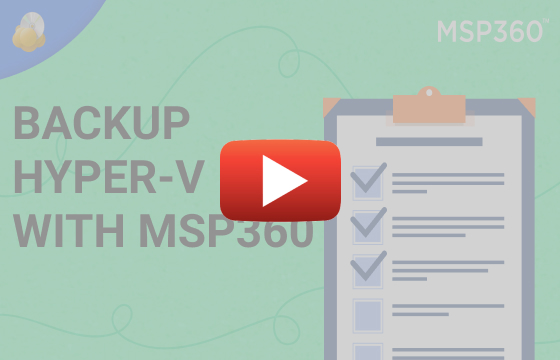MSP360 Products
How to Back Up Hyper-V Virtual Machines in MSP360 Managed Backup Service
In this guide, we will overview the backup of Hyper-V virtual machines with MSP360 Managed Backup Service, both with the web console and the backup agent.
Creating a Backup Plan with the MSP360 Web Console
Please note: you can back up machines from local Hyper-V only. The solution works with Windows Server 2008 and above. Also, you can enable the Hyper-V role on Windows 10 Pro, Enterprise, or Education.
Go to the Remote Management tab and find the computer with your Hyper-V. Note that the product version should be Virtual Machine Edition.

Click the gear icon and then Show Plans.

Hit the plus button and select Hyper-V in the Backup section.

Now it’s time to specify the settings of your plan.
Name the plan and select the option to copy the plan configuration to the storage if needed.

Choose the type of backup and the storage.

Define what machines to back up: all, only running, or specific ones. If you need a particular machine, type its name in the window below.

Specify compression and encryption. For encryption, set up an algorithm and password. Change storage class if necessary.

Retention Policy determines how many copies of your machine to store. You can delete “old” versions and set up how many copies to keep.

Specify the backup plan schedule. You can run it once manually or at an exact time – or set up recurring backups. To enable this option, scroll down a bit and switch on the Recurring option in the Incremental Backup section. Set up the schedule.

Then, go back and do the same next to the Schedule Options header, which relates to full backup.

Add pre / post actions if needed. Here, you can add scripts that will launch before or after the plan, or specify what backup plan to run after the current one.

Specify the notification parameters: whom to warn if the plan succeeds, fails, or fails partially.

Hit Save. You’re done.
Creating a Backup Plan with the MSP360 Backup Agent
Another way to create a plan is to use the MSP360 Managed Backup Service agent.
Run VM Edition. Click Hyper-V.

Choose a storage account on which to back up your virtual machines.

Name your plan.

Choose virtual machines that require to be backed up. You can select all of them, just those that are running, or define them manually.

In the next step, define your Compression and Encryption Options.

Specify the Retention Policy. Click the options link to check whether the default options are suitable for you.

Create a schedule if you want to back up your machine regularly.

Add pre- or post-backup actions, if needed. These options allow you to run a script before the plan is executed, or right after it. The last one is for a chain backup – you can tell the solution to run the next backup immediately after this one.

Check your backup plan summary.

Run the backup plan. It might take a while – the time depends on the volume of data.
Now your virtual machine is ready to be saved. Later, you can restore it as a virtual disk or as a fully-fledged virtual machine. If you have any further questions, please contact our pre-sales team.



